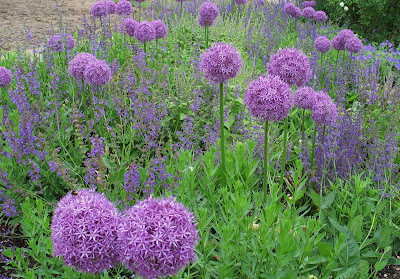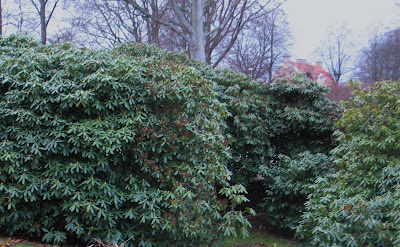This cold and snowy winter I decided to spend one month in Kenya. So far I dont regret that at all. Here below you see some pictures from a little roundabout ourside a private garden planted with many different plants including cabbage plants, Tulbaghia violacea, Bougainvillea and Lavandula.
Friday, 31 December 2010
Tuesday, 30 November 2010
The Allium structure
Allium is a very useful genus in nearly all kind of garden design. Especially the species with big rounded flower heads are good contrast makers among plants with different structure. Here are three nice examples from England.
Allium together with the delicate Salvia.
Allium goes wild with Ranunculus repens
Allium and the later flowering Hylotelephium
When you plan your perennial border you might want it to flower from early spring to early winter if possible. In that case, however, the border will probably never reach a real peak with sumptuous blooming. Instead it is better to put effort on a certain period of the year, for instance from late summer to early autumn.
Allium aflatunense and its cultivars are also very useful as a late spring or early summer element in such late summer flowering plantings.
Friday, 26 November 2010
Early winter on the prairie
Rattle snake master, Eryngium yuccifolium and Canada Wild Rye, Elymus canadensis
Thursday, 11 November 2010
Inside the green cave
Inside the cave, a newly made green playground for the kids
The entrance to the Kid's Cave in the city park of Laholm
Monday, 11 October 2010
The woodland is turning color
Nyssa sylvatica, the Tulepo tree
The woodland in Laholm was planted in 2008 and is a part of the city park under development. New exciting departments are added constantly, now latest an amazing spring bulb planting and next spring we are creating a European meadow with both acid and more calcareous habitats with a huge diversity of meadow plants.
Tiarella, Gillenia and Acer rubrum
 |
| Acer rubrum 'Scanlon' just outside the woodland |
Thursday, 7 October 2010
The Spring Slope
The Spring Slope starts here and follows the pathway to the left
Next week it's time for the first part of the Spring Slope in the city park of Laholm to be created. This is an area in the park there it formerly was a rough lawn beneath old beech trees. When next spring is here it instead has turned into a wonderful carpet of blooming bulbs and other spring flowers in white, blue and violet shades.
As dominating bulb for the slope we have chosen the dark blue Siberian squill, Scilla siberica. She will be accompanied by many other bulbs and corms like the true wild form of the italian Spring crocus Crocus vernus v. albiflorus, the Grecian windflower, Anemone blanda, many different cultivars of the Wood anemone, Anemone nemorosa, the Striped squill, Puschkinia scilloides and a lot of other lovely spring flowering plants.
I'm already longing for next spring.
Wednesday, 22 September 2010
The Annual Perennial Course in Alnarp
In early September we arranged the annual three days course about perennials in Alnarp again. This course deals with every aspect of the use of perennials in gardens, parks and city spaces and is intended mainly for professional landscapers, staff from municipalities, garden journalists and people from nurseries and Garden Centers.
The second course day the participants are given three alternative places there they are supposed to chose one and make a planting plan with suitable perennials. They have to consider both aesthetic values as well as the plant habitat issue.
The coffee breaks are not only cozy interruptions of the lectures but also important moments of discussions and an opportunity to create new contacts.
The last day we focused mainly on habitats and biotope plantings. Peter Korn delivered a very much appreciated lecture about natural steppes and steppes as a garden theme. Hopefully the participants left the course with fresh inspiring ideas and new suitable knowledge.
If you want information about the most recent perennial course you can find that on the blog "utan stängsel" at the page Stora Perennkursen.
The coffee breaks are not only cozy interruptions of the lectures but also important moments of discussions and an opportunity to create new contacts.
The last day we focused mainly on habitats and biotope plantings. Peter Korn delivered a very much appreciated lecture about natural steppes and steppes as a garden theme. Hopefully the participants left the course with fresh inspiring ideas and new suitable knowledge.
If you want information about the most recent perennial course you can find that on the blog "utan stängsel" at the page Stora Perennkursen.
Subscribe to:
Posts (Atom)






















